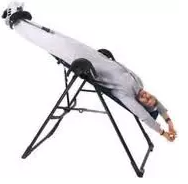
I am often asked if inversion tables are helpful for stretching and relieving pain or are they a fad or gimmick? The answer is yes, they can be helpful for neck, mid-back, lower back, hip or knee pain.
Inversion tables are not a new idea. They have been around since the 1970’s and some physiotherapy clinics still use inversion therapy. The designs have improved and the costs have come down in recent years for consumers. They can be used as a cheaper but less effective alternative to mechanical traction therapy. Inversion tables can also be a helpful therapy device at home which is where most are used. More on this later in the article.
How do Inversion Tables Work?
Inversion simply means being upside down or at an inverted angle (see picture). Before someone can invert, the feet and ankles must be anchored into the locking mechanism at the bottom of the table. This will allow the person to fully relax while inverted, which is very important if the table is going to provide any benefits. Then a person can slowly invert by using their arm position to provide some momentum, leverage, and counterbalance. The tables are very well balanced and it is easy to control the amount of inversion and to come back to an upright position by using altered arm positions or the handles.
What is the Purpose and Benefit of Inversion Tables?
Inversion tables create the reverse effect of gravity on the body’s joints and muscles. The joints, muscles and entire body is decompressed at all points past the ankles all the way up to the neck. It causes the body and skeletal system to be unloaded and pulled the opposite direction of gravity. Imagine the day to day pressures on your joints from gravity with walking on pavement, sitting at a workstation, and running up and down stairs.
In some physiotherapy clinics, mechanical traction machines are used to treat painful conditions of the spine. It has the same purpose and benefits as inversion tables. Traction machines are more effective, however, because the forces are targeted more specifically to an injured area and the amount of force can be controlled better. For more traction information see our services under “Spinal Decompression” (Traction). As a Physiotherapist, I often recommend to people with chronic back pain to use an inversion table for home treatment.
What are the Risks of Inversion Tables?
People who have heart disease, high blood pressure, eye diseases (such as glaucoma), are pregnant or have acid reflux of the stomach are at a higher risk to inversion therapy and should consult their physiotherapist and doctor about it first. The first time anyone tries inversion therapy they should be sure to have someone standing by, in case assistance is required to get out of the apparatus, or if health problems are experienced.
Here are some guidelines on how to use inversion tables:

- For the first few times, invert only to an angle of about 30-45 degrees below the horizontal. Allow the body to adjust to being inverted gradually. Progress to full inversion over a number of sessions as you feel comfortable.
- Invert for only 1-2 minutes and then return to horizontal again. Do this repeatedly for 5 minutes to start and progress to about a total of 20 minutes over a number of sessions. Always do the inversions in sets of 1-5 minutes. Do not exceed 5 min. of inversion at one time. Even a few sets a day can be helpful.
- Use inversion once daily for health maintenance, and up to 3 times a day for painful conditions.
Inversion tables can be a good complement to a total body fitness program. It can also be part of an affordable home program to control and treat painful back, neck, muscle, joint, tendon and ligament conditions.
By Kelly Milan, BMR, PT ©




